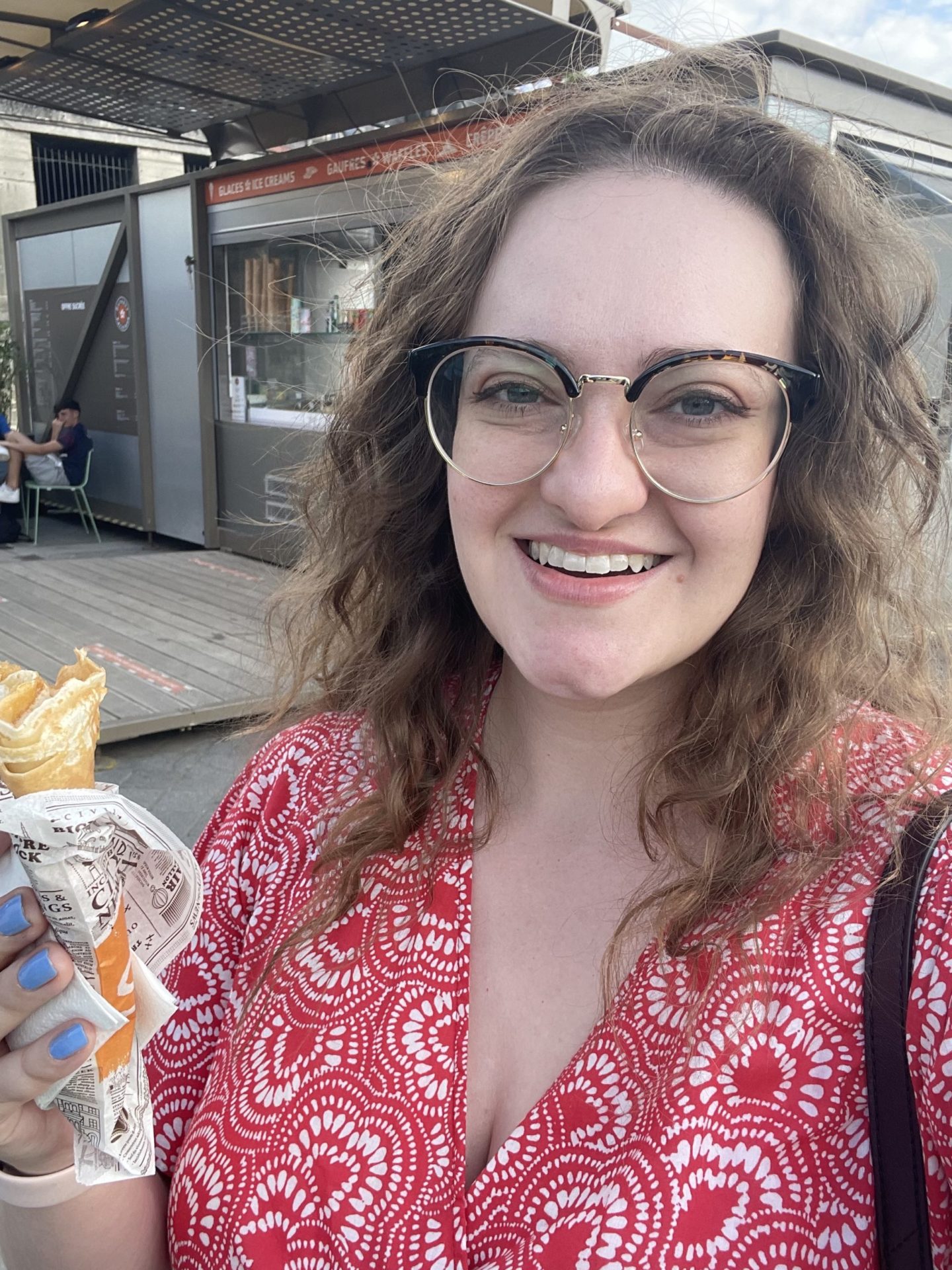Farm to Table to Body at the Frist
Jean Anthelme Brillat-Savarin said, “tell me what you eat, and I will tell you who you are.” Food is intrinsically tied to our identities. The time period we are in, the place we
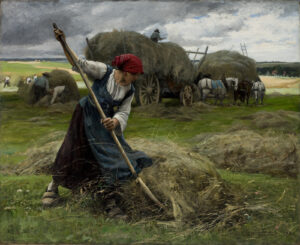
live, our socioeconomic class, much more than just personal taste, affect what we eat. The Frist Art Museum’s new exhibitions, Farm to Table: Art, Food, and Identity in the Age of Impressionism and Tennessee Harvest: 1870s-1920s explore these themes. The focus of these exhibitions is food in all its stages: production, preparation, and consumption.
In the first exhibit, the audience is invited into a look at France’s food through almost 60 works from the late 19th century divided into five sections: farming and husbandry, marketplace, food workers, still life, and places where French men and women consumed meals. In the first section, farming and husbandry, we see images of the labor it takes to produce food. The piece that first caught my eye was Haying Scene by Julien Dupré which depicts a woman turning hay. She is clearly doing hard labor, but she is bright and beautiful. Her work is necessary and appreciated. The exhibit also includes La Meule (The Haystack) by Claude Monet, one of the 25 haystacks that he painted showing heaps of harvested grain.
Markets and shops are the focus of the second section. On a wall by itself is the piece that inspired the curator, Andrew Eschelbacher, to assemble the exhibit: A Rat Seller During the Siege of Paris in 1870 by Narcisse Chaillou. During the Franco-Prussian War, the French had so little to eat that they resorted to butchering and eating rats. Rather than something to be ashamed of, this becomes a point of national pride. The painting is not bleak and depressing. The colors of the French flag adorn the walls and the butcher is almost smiling as he rolls up his sleeves, rosy cheeked. It’s as if he is saying, “Yes, we’re eating rat, and what of it? It will taste better than the steak filet cooked by any other country.”
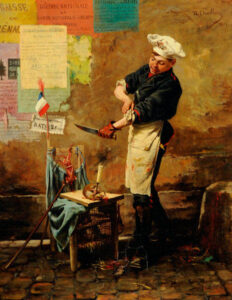
Other paintings, such as Fish Market at Les Halles by Victor Gabriel Gilbert, show the differences between social classes: a wealthy woman and her servant as well as the sellers, and how the market brings them together. The third section of the exhibit features food workers: cooks, butchers and servers. The viewer is reminded that this is another step in food preparation that must be appreciated. While slabs of meat, such as in Meat Haulers by Victor Gabriel Gilbert are not beautiful to look at, there is a beauty in the work to be done. The museum label provides interesting context as well: “The neighborhood surrounding Les Halles had been the site of violent uprisings in Paris, and authors frequently used descriptions of animal carcasses as metaphors for revolutionary corpses.” The fourth section is comprised of still lifes of meat, fish, fruits and vegetables. Prior to this exhibit, I had given very little thought to still lifes other than how boring I found them. What a delight to learn that these paintings contain hidden messages and symbols. Gustav Courbet’s painting of apples for example, is a political message, symbolizing his support of the working people. The Dessert (The Remains of the Meal) by Étienne-Prosper Berne-Bellecour depicts a decadent scene of a leftover feast with sugar cubes and sweet delicacies to remind the viewer of France’s dependence on colonial sugar production. Still Life with Pomegranates by Henri Regnault shows shriveled, old pomegranates on a blanket. The museum label tells the viewer that decayed fruit in still lifes serves as a memento mori, a reminder that we will all die and decay.
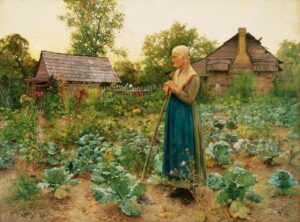
The last section is places that French people ate their meals. The section beautifully highlights the different social classes in France at the time. Some are comfortable salons filled with people as in La Brasserie by Jean Béraud. Others are more intimate scenes like the couple enjoying a simple meal in Under the Lamp by Marie Bracquemond. And still others show harder lives, like that of the young domestic worker in Girl Eating Porridge by William-Adolphe Bouguereau and the young, impoverished girls in The Orphans by Léon-Jean-Bazile Perrault.
The end of the fifth section leads the viewer directly to the next exhibit, Tennessee Harvest: 1870s-1920s. This exhibit shows connections between paintings made in Tennessee or by Tennesseans to the French art in the previous exhibit. Not only are the paintings similar, but some of the Tennessee painters were actually taught in France by painters in the first exhibit. In the Tennessee Mountains by George W. Chambers shows an old woman standing in her patch of cabbages, weary but determined. It has some similarities to Haying Scene by Julien Dupré who was his teacher.
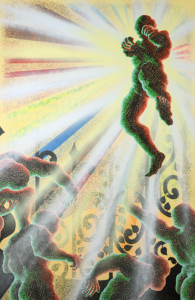
The Frugal Repast by Willie Betty Newman was painted in France by a native Tennessean. She studied under William-Adolphe Bouguereau and similar to his Girl Eating Porridge, her painting also shows a peasant girl eating, but her girl has paused to look right back at the viewer. As the exhibit goes on, we are invited to recognize what the paintings omit: black farmers and enslaved people that made this agricultural society possible. I was expecting to enjoy the Farm to Table exhibit, and I did very much, but I didn’t realize how much I would love the Tennessee Harvest exhibit. I didn’t know any of these artists previously and I was surprised how much pride I felt seeing such beautiful paintings done by Tennessee artists. Despite having no family from Tennessee, I felt as if it could be my ancestors peeling apples in Women at Work by Lloyd Branson.
While you’re there, go to the always innovative Gordon Contemporary Artists Project Gallery (CAP Gallery) to see M. Florine Démosthène and Didier William: What the Body Carries. This is an exhibition of works by two Haitian American artists that explores diversity and the immigrant experience. I was fortunate enough to hear both artists speak and they addressed the ignorant and hurtful claims made publicly by several administration officials. Démosthène and William reminded us that this kind of bigoted and hateful speech is nothing new. Redemption, Resurrection by William is particularly powerful piece that shows his oldest brother as a superhero, defending his other brother from bullies. Both artists use eyes in their work, having the subjects look back at the viewer rather than just passively allow themselves to be observed.
All of these amazing works will be up through May 4, 2025. There’s a delightful cafe in the Frist downstairs. Make a whole afternoon of it; you wont regret it!

